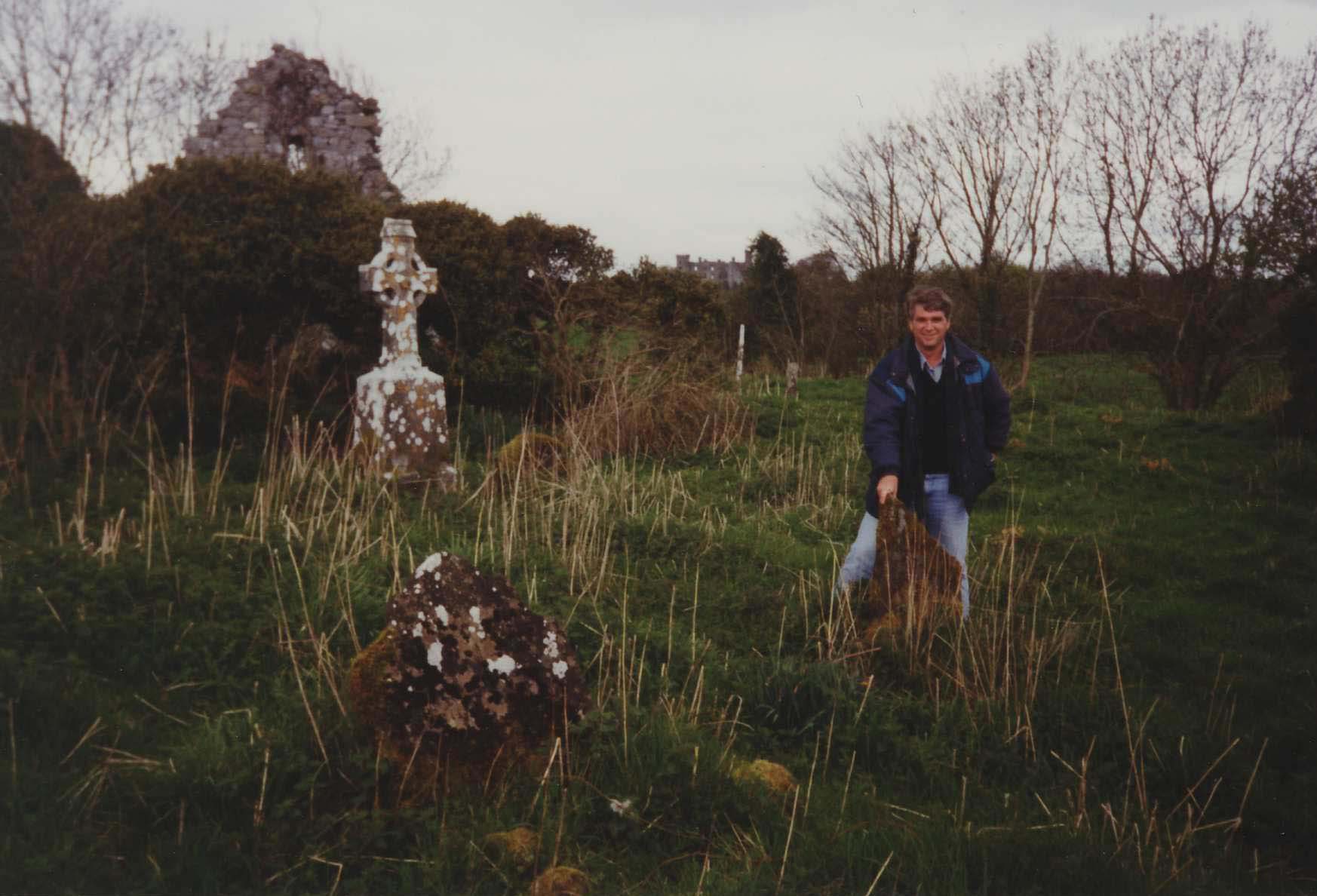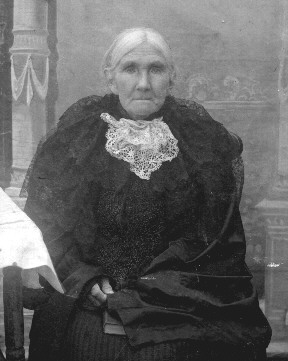
CHAPTER SEVENTEEN London & Clonmellon:- An unlikely union
The arrival at Port Philip on October 18th 1848 must have been a welcome relief to the 221 assisted immigrants aboard the "Tasman" whatever the apprehensions they may have held about their future in a new and strange land. Ten of their number who had set out from Plymouth on June 15th (three adults and seven children) had perished during the 120 day voyage. Among the survivors were Bridget O'Neill (49), a widow, her two sons Thomas (20) and Patrick (15), and daughter Mary (18). According to the shipping records of the "Tasman" all were Catholics, and the two boys were able to both read and write. Mary was able to read only, whilst Bridget could neither read nor write. 1 The place of origin of the family was recorded as Clonmellon in Co Westmeath, Ireland, where all of the children had been baptised. 2
Bridget was a daughter of John Quinn a farmer and his wife Mary (maiden name unknown). My DNA test described in Chapter 1 contains no surprises about my maternal ancestry. (Mitochondrial DNA is transmitted from mother to daughter to daughter etc. It is also transmitted to male offspring but not to their descendants. Thus my mitochondrial DNA is inherited from Bridget Quinn, her mother Mary and her maternal ancestors). From distant origins in Africa carriers of my DNA moved via the middle east and gradually spread westwards to Europe to modern day Scandinavia and the British Isles beginning about 15,000 years ago.
At about the age of seventeen Mary married Denis O'Neill at Castletown, most likely the townland of that name in the parish of Delvin a neighbouring village to Clonmellon in Co Westmeath. Denis was a gardener, an occupation that was to be later taken up by his two sons. A family tradition asserts that he was a "descendant of Chieftain O'Neill" but the accuracy of that claim remains to be verified. A further tradition has it that Denis in fact saved the life of his future wife when he pulled her out of the path of a speeding carriage. At the time both were in the service of the same employer, he as a gardener and Bridget as a housemaid. 3 Given Denis was a gardener this event probably took place at Killua (a few miles from Clonmellon and in the neighbouring county of Meath) as this was the estate of the Chapman family who established themselves there during the 18th century as the local (Protestant) landlords. The Chapman's built an imposing "castle" as their residence, the ruins of which could be seen from the Clonmellon-Kells road at the time of my visit. The building has since been restored. Many of their tenants and those who worked on the estate lived in nearby settlements such as Kilrush and Clonlough, but the nearest Catholic priest available to perform baptisms would have lived in the village of Clonmellon built by the Chapmans in the early 19th century. 4
According to the baptismal records seven children of Denis and Bridget were baptised at Clonmellon. They were James (Jan 25th 1815); Dennis (Nov 17th 1820); James (Nov 19th 1822); Dennis (April 10th, 1826); Thomas (July 9th 1827); Mary (April 12th 1830) and Patrick (April 23rd 1833). Kilrush was stated as the place of residence of the parents at the time of the older James' baptism but for the remaining children it is Clonlough. It is possible that there were other children as well, as the parish records are incomplete especially from 1809 to 1819. Of the children listed, presumably the first two mentioned died young as succeeding children were given their name, and as only Thomas, Mary and Patrick accompanied their mother to Australia it would seem likely that the other two had either died as well, or perhaps as they would have been adults by this time, they may have chosen to remain in Ireland. The population of Co. Westmeath declined from 141,300 in 1841 to 111,407 in 1851 due to the famine and subsequent emigration. The death of Denis O'Neill Sr (or Neill as the name is recorded in the baptismal registers and shipping records) was recorded in the Clonmellon register as taking place suddenly on June 23rd 1843, but the precise place of burial is not recorded. Probably it was in the now abandoned graveyard at Killua where a number of the Chapman family also lie buried. 5

Old graveyard at Killua near Clonmellon. Denis O'Neill is almost certainly buried somewhere here. The ruins of the grand house which once belonged to the Chapman family is visible on the horizon in the distance. Possibly Denis and his future wife Bridget were both employed there.
Upon arrival in Victoria, both Thomas and Patrick were employed by Mr W Roadknight of Geelong at a wage of 20 pounds per annum, with rations, for three months. Bridget is recorded as having gone with her sons in the employ of Mr Roadknight as well, but Mary apparently took up a position as housemaid with a Dr Wilmott of Brighton at 18 pounds per annum with rations. 6 For whatever reason, possibly because of the separation from her family, this arrangement for Mary did not last, as it was only a little over six months later that she was to marry George Watkins at St Marys Church in Geelong. The wedding took place on April 22nd 1849 and was witnessed by the bride's brother Thomas, and an Annie Plunkett. Of the two participants and the two witnesses, only Thomas was able to sign his name in the register. The celebrant was Fr Dowding. 7
George Watkins was a brickmaker by occupation. He had been born in London probably on 28th Oct 1821, the son of George Watkins, a coachman, and Elizabeth (maiden name unknown). 8 As his daughter Margaret, my grandmother, was ever anxious to point out George was "an English gentleman" who "paid his own fare out". This would seem to be true as no record of his arrival can be traced - whilst records of assisted immigrants to Victoria are largely complete, records of those who were unassisted (ie. paid their own way) are not. Margaret also recalled hearing that her parents first met within a few days of Mary's arrival, and again considering the dates of arrival and of the marriage this would seem to be an accurate recollection. 9

Mary O'Neill
George's brickmaking business was established in Belmont just off the Barwon Heads road. He and Mary raised a family of ten children: George (b 1850 but who died in infancy); Bridget (b 1852); Elizabeth (b 1854); Ellen (b 1857 but who died the following year); Thomas (b c1859); Mary (b 1862); Louisa (b c1865); Denis George "George" (b l868); Margaret (b July 12th 1870 at Belmont) and Teresa Ada "Ada" (b.1873) 10
One story from this period survives which sheds some light on the characters of Mary and George. Although Mary was a Catholic, as has already been noted, George was not - although he did become one after the death of his wife. At the time of this story his support for his wife's religion did not extend to the point where he was prepared to have his children travel into Geelong to attend a Catholic school (presumably St Mary's) when there was a local non-Catholic school at Belmont. (St Bernards Catholic School in Belmont did not commence until 1873.) After over-riding his wife's strenuous objections to this decision, George awoke the next morning to find no breakfast prepared, no fire lit, the cow not milked and sundry other chores normally performed by his wife left undone. Upon enquiring the reason for this state of affairs he was informed that since he had taken it upon himself to supervise the education of the children he may as well take over all the areas of responsibility that were normally assumed by his wife. George apparently knew when he was beaten and is reported to have conceded with the remark "Have it your own way then woman!" and never again "interfered" in this area. 11
During this time Mary's mother Bridget passed away. Her death occurred at Little Ryrie St Geelong on November 17th 1862 and she was buried in Geelong's Eastern cemetery, the Very Reverend Dean Hayes conducting the burial service. 12
George and Mary later moved from Belmont into Geelong and occupied a house at 191 Yarra St, directly opposite St Mary's church. This move took place sometime after March 1895 as they were still living in Belmont at the time of the death of their youngest son George, which occurred on March 31st of that year. The funeral left from the family residence in Belmont on Tuesday April 2nd for the Eastern cemetery. 13 Many of the other children of the family were married by this time and had commenced families of their own (see next chapter). It was at the house at 191 Yarra St that Mary quietly passed away on Feb 18th 1904 aged 73 years. Her husband survived her by a little over three years before he died on Sep 6th 1907 also at the Yarra St house. He was 86 years of age. Both George and Mary are buried alongside their son George in Geelong's Eastern Cemetery. The grave is marked by a fence and small monument. 14

GO TO CHAPTER SEVETEEN FOOTNOTES
GO TO CHAPTER EIGHTEEN
RETURN TO CONTENTS PAGE